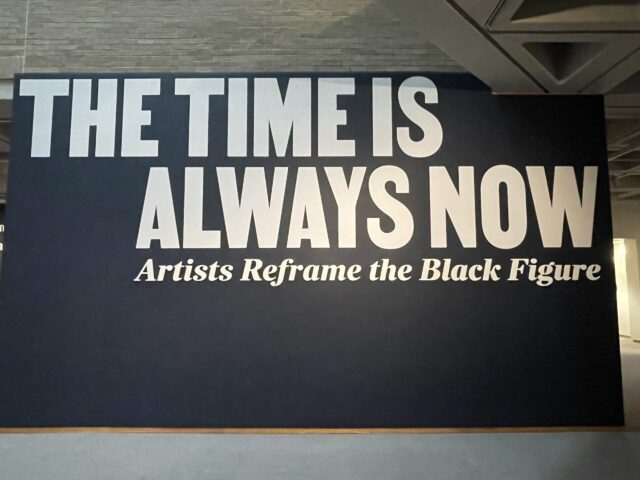As a known homebody, I encourage myself to go outside every month. At the top of May the North Carolina Museum of Art came through for me as it tends to do. I viewed their latest special exhibition, “The Time Is Always Now: Artists Reframe the Black Figure”. The email announcement caught my eye in March, and I immediately purchased my ticket. Artists of the African Diaspora celebrating the Black figure and Black life, say less.
The exhibit is curated by Ekow Eshun, a London-based curator, critic, and writer. The title, “The Time Is Always Now”, references a James Baldwin essay, “Faulkner and Desegregation” per my estimate, and features the work of 23 artists. The exhibit encompasses three sections “Double Consciousness”, “Past and Presence”, and “Our Aliveness”. Artists speak to the experience of being in and outside of dominant society concurrently, reach back in history to highlight and exalt where we were minimized, and celebrate the richness of our daily lives.
Instrumental music fills the gallery with complimentary sound as visitors take in the paintings and sculptures. Artwork pops on bold olive green, matte cherry red, and navy blue walls. Each piece is a reclamation of identity from the artists. Individually and collectively, they are a celebration of Black people across the African Diaspora. We have always existed, whole and noteworthy, and will continue to exist. Attempts to erase us never have and never will succeed.

In a world determined to crush our spirits, we must center ourselves and the artists do so spectacularly. “Double Consciousness” features Amy Sherald’s focus on the confidence of her subjects. Wangechi Mutu reclaims African inspiration appropriated by European artists. Thomas J. Price challenges who receives public praise with his beautiful, towering bronze sculpture. Nathanial Mary Quinn reveals intermingled layers of public persona and personal life.

The exhibit reaches back to honor our forebearers in “Past and Presence”. Lubaina Himid offers a serene transition for brutally abandoned enslaved Africans. Enslaved servants are elevated in reimagined European art as Barbara Walker relegates white aristocracy to near invisibility. Titus Kaphar replaces them completely, allowing the present to peer into and connect with the past. Kimathi Donkor recenters female leaders in their fight for freedom during enslavement.

“Our Aliveness” is as bold and vibrant as we are on the daily. Toyin Ojih Odutola imagines Nigerian aristocracy without the disruptive transatlantic slave trade. Njideka Akunyili Crosby’s self-portrait is made of layers that compose us all, our experiences, memories, and influences. Jordan Casteel captures her community, the familiarity and proximity of neighbors weave the landscape’s fabric. Vibrant spirits shine from Henry Taylor’s canvas and their histories reflect the powers that shape American life.
No one else can grasp our expansiveness, depth, and variety like we can. The artwork’s bold colors and techniques match the richness of Black personhood. We have a deep understanding of land, music, storytelling, self-expression, and spiritual connection. Everything that keeps a person and their spirit grounded as they experience human life. At no time have we been less than, even when treated as inhuman.
Black people are grand even through the trauma of colonization, displacement, and enslavement. I wonder how our global community would look if we had been left alone. Not from a place of shame but from fascination because we are unstoppable and inevitable. I carry zero shame for the lives my ancestors lived. How can I be ashamed of the people who survived and made it possible for me to exist? They may or may not have imagined me but I’m grateful to think of them and see their experiences centered and memorialized.
“The Time Is Always Now: Artists Reframe the Black Figure” is on view until June 29th, 2025.
